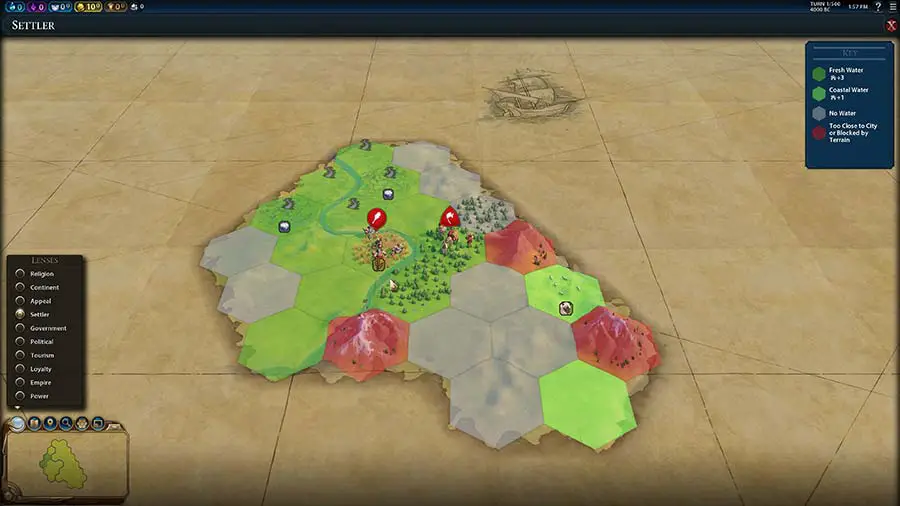
There are numerous kinds of terrains and resources in Civ 6. With such a wide variety to choose from how do you know what’s the very best starting point for your fledgling empire? How do you decide?
The best tile to start your first city on is a plains/hill tile, preferably with a luxury resource. When deciding, look for adjacent tiles that have a total of at least 4 resources available and always start your first city next to a freshwater source, preferably a river. Using the Settler lens is probably the easiest way, just look for dark-green tiles.
Civ 6 Settler Lens
Using this lens will allow you to see what tiles are best suited for cities that are within your line of sight. It can be activated by clicking on the lens icon at the bottom left of the screen and then selecting it from the pop-up menu.
It will highlight tiles in various colors and will also display the bonuses in each tile, if any.
- Red tiles mean the tile can’t be used for settling. It’s either in unusable terrain or too close to another city.
- Dark green tiles are the best since they have access to fresh water and will give a city a +3 housing bonus.
- Light green tiles are coastal tiles. They’ll give a city a +1 housing if used.
- Gray tiles are usable but don’t give any housing bonuses. Their value could line in a possible strategic bonus, like providing a chokepoint.
Clicking on the Settler brings up another useful view. In this view you will see an icon for any tiles your advisor thinks are the best for founding a city, plus a summary of why it is a good tile. A good reference but the advisor doesn’t know what your specific goals are that you have in mind. In the end, it can be used as a sanity check, but your judgment should always prevail.
Plains-Hills Tiles Are The Best
Plains Hills tiles are the best for founding a city. These tiles start with 1 food and 2 production. Any tile a city is started on will always produce at least 2 food and 1 production, no matter what it could produce originally. Starting a city on a plains/hills tile will still force food output up to 2, while leaving the production number alone at an output of 2, starting your empire out with an extra production unit per turn.
If you get lucky enough to find a plains/hills tile with a luxury resource all the better. Founding a city there will give you access to that luxury even if you don’t have the technology for it yet. In the early game you can sell it to the AI for additional income. Once you found that first city you might not have any idea about what to build first. Check out my early game build order page for some help.
Civ 6 City Location Considerations
Founding cities next to fresh water is extremely important for city growth. One of the best fresh water sources is a river since it gives a +3-housing bonus. Rivers really aren’t individual tiles; they actually flow between tiles. They also give a +5 bonus against melee attacks from the other side of the river.
A good location is one that provides a lot of needed strategic resources and that can provide good adjacency bonuses for districts, like having mountains for bonuses for Campus districts. A good location also needs to have as high a production potential as possible and it will have other bonuses as well, like science, culture, faith, or gold, just to name a few.
Another consideration that can be overlooked is strategic positioning. One good example is a choke point. Controlling one of these with a city can make defending your borders a lot simpler since an enemy must pass through a chokepoint to press the attack, making it easier to concentrate your forces for an effective defense.
Finding all this at the same time only happens in an ideal situation. The best thing to do is to look for a good fresh water source and then look for the most resources available within three tiles.
Consider your civilization’s victory conditions when locating cities. Want a religious victory? Mountains are good for religious victories because of the campus adjacency bonus. A coastline is good for culture victory because of seaside resorts. The thing to remember is what type of victory condition you have in mind and then place your cites in a way that helps that strategy.
Watch for additional bonuses that are unique to your civilization. For example, Mali gains 1 extra gold for international trade routes for every flat desert tile controlled by the city the trade route starts from. This is one of the few times owning desert tiles can be a good thing. Founding cities close to a few desert tiles could fit nicely into this empire’s strategy.
The Netherlands is another example. It gets bonuses for being on rivers so exploring along rivers is a good idea.
Not all civilizations have these bonuses but for those that do it should be exploited.
Tiles Close To The City Are Important in Civ 6
The first two rings of tiles around the city are important and are the next to most important consideration after fresh water. The first ring of tiles is immediately available, the second ring becomes available as the game goes on, so it’s good to keep any food bonus tiles in the first ring so you can get more growth out of your city early on. Not only do you want to watch for tiles with a bonus, strategic or luxury resource, you also need to consider the total output of the tiles when all the resources are added together. Total yields of 4 or more are the target, more is even better. This applies to both the first and second rings of tiles around the city. The third tile is worth considering but it will take a while for the city to expand enough to use them. By then another empire’s city may have claimed them, making them unusable to you, so they are less important than the first two rings.
If your Settler is not in an ideal location it’s okay to move him up to a certain number of turns. Scout around with your warrior first. Moving your Settler for two turns is okay, 3 turns may be okay if necessary but no more than that. While you’re using turns moving your Settler many other empires have already founded their starting city and ramped up production. Unless you have a really strong starting position after moving that enemy empire’s head start will be very difficult to overcome.
Civ 6 Where to Settle a Second City
When settling additional cities, most experienced players agree that they should be founded about 4 tiles from each other. “Clustering” them together makes them easier to defend and can provide adjacency bonuses for districts. Having cities a little closer together helps with loyalty and religion as well (loyalty is part of the Rise & Fall expansion, so if you don’t have that expansion you won’t need to worry about loyalty).
And the same as before, you should always be looking for high production tiles and claiming them whenever possible. Knowing the total yields from all the close by tiles is still good to know but that isn’t the only important consideration when starting new cities.
The first thing to remember is that a new city can’t be started within 4 tiles from any other city center. Fresh water sources and plains/hills tiles are still the best location for a city but founding one close to a mountain is another consideration since they give a significant boost to production (+2). They also provide a great natural defense against foreign invasion since they are impassable. The drawback is they yield no natural resources.
Another resource to look for in the early game is horses. Getting access to horses will enable you to build combat units that are faster, making it easier to defend your territory. Another tile type to consider founding a city on is a rice tile. This will produce 3 food for the city, making it a city well-suited for growth. Just like your first city try to keep food bonuses within 1 tile of the city center and strategic resources within 2 tiles.
There is no penalty in Civ 6 for creating new cities. The best rule of thumb is to establish as many as you can adequately defend. Another thing to be careful of is amenities. If you don’t have enough to go around some cities might revolt. Also, try to keep district placement in mind. Try to plan ahead so you can get the maximum benefit from them for all your cities.
It’s not a good idea to settle close to an enemy city unless you have other cities close by to support it. A lone city can easily fall to another empire’s influence. It’s always best to settle cities in groups.
Harbor tiles provide an extra trade route. This typically gives about 2 more food and 2 production early game. These also give 2 gold if next to the City Center and it also provides extra housing.
How Do You Settle In Civ 6?
It takes a Settler start a new city. A Settler can only start one city and is used up in the process, so another Settler will be needed to start another new city. Cities must be founded on land and it has to be accessible. Cities can be placed on any land tile except an Oasis or Natural Wonder. Most of the terrain features will be removed once a city has been placed on the tile.
If a city is built on a tile with a bonus resource, regardless of whether it’s a strategic or luxury resource, the city gains the use of that resource and it’s yields. As previously stated, a city must be at least 4 tiles away from any other City Center.
When scouting around you can use the Settler’s Lens to help find the most suitable tiles for use.
Don’t forget to visit my YouTube channel at https://www.youtube.com/channel/UCcWU6qxVisK93h5guKRVtdg
You can read my Civ 6 review here.
